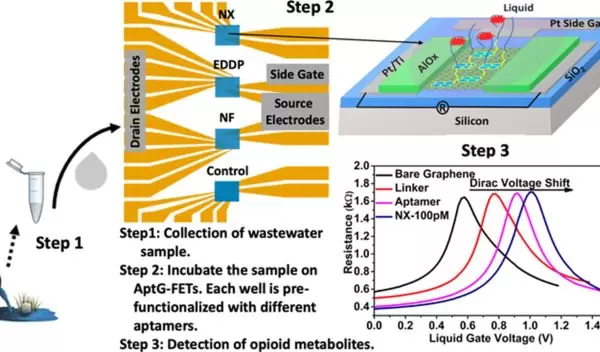
Faster-acting graphene sensor detects opioid metabolites in wastewater
A sensor that detects opioid byproducts in wastewater faster and cheaper than current commonly used methods has been developed by U.S. National Science Foundation grantee researchers.
The graphene field effect transistor device can detect four natural and synthetic opioids simultaneously. The team published the research in ACS Nano. The instrument can be used to monitor opioid use without violating privacy, a primary concern in the response to the ongoing opioid crisis.
The device is an emerging application of the growing wastewater-based epidemiology field, a discipline that has recently been deployed to measure coronavirus levels.
"The new sensor is able to rapidly, cheaply and easily measure opioids in wastewater," said Kenneth Burch of Boston College, a lead author of the report. "Its sensitivity and portability allow for wastewater-based epidemiology at the local scale -- as specific as block-by-block or dorm-by-dorm -- while ensuring privacy."
"Wastewater testing is an emerging strategy that can defeat the limitations and stigma associated with individual drug testing, and provides a more objective measure of drug use at the neighborhood level," said Avni Argun, a co-leader of the project and vice-president for advanced materials at Giner Labs in Newton, Mass.
While wastewater testing has been widely conducted in Europe, only a few studies exist in the U.S. The rapid and portable nature of the team's device would allow wide-scale population testing at low cost and high geographic resolution.
The undertaking marks the first time graphene and graphene-based field effect transistors have been used to analyze wastewater to detect multiple metabolites.
"We are also working to see what else the platform can be used for, such as rapid at-home testing of viral infections and/or the presence of pathogens in wastewater," Burch noted.


